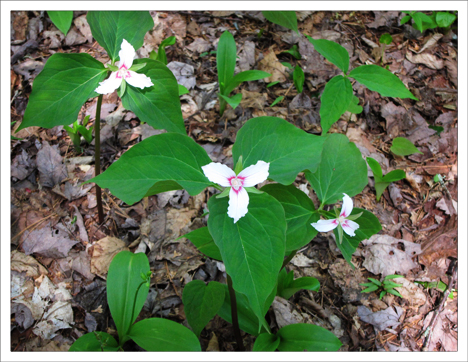Adirondack Wildflowers:
Painted Trillium (Trillium undulatum)
 Adirondack Wildflowers: Painted Trillium at the Paul Smiths VIC (19 May 2012)
Adirondack Wildflowers: Painted Trillium at the Paul Smiths VIC (19 May 2012)
| This page is no longer being updated. For an updated and expanded version of this material, see: Painted Trillium (Trillium undulatum) |
Painted Trillium (sometimes called Painted Lady) is a wildflower that sports a single elegant white flower, splashed with bright pink above three, large, blue-green leaves. The flower is usually 2 inches wide. The petals are lance-shaped and have a tapered, pointed tip. The flower is followed by bright-red fruits, which appear in early fall. The flower has an inverted, pink V at the base of each white, wavy-edged petal. The flowers are pollinated by Insects. The plant is 8-20 inches tall.
Painted Trillium can be found in cool, moist woods and swamps. It grows in full shade (in deep woodland) or semi-shade (in light woodland). This plant is usually found beneath acid-loving trees such as eastern white pine, red maple, red spruce and balsam fir. Painted Trilliums grow in eastern North America, from Nova Scotia to Ontario and Wisconsin, south to Georgia and Missouri.
 Adirondack Wildflowers: Painted Trillium in bloom at the Paul Smiths VIC (16 May 2012)
Adirondack Wildflowers: Painted Trillium in bloom at the Paul Smiths VIC (16 May 2012)
Painted Trilliums may be seen on many of the trails at the Paul Smiths VIC. They are particularly abundant on the western portion of the Heron Marsh Trail, between the floating bridge and the Heron Marsh boardwalk. Trilliums usually bloom in May.
References
- Lady Bird Johnson Wildflower Center. Native Plant Database.
- United States Department of Agriculture. Plants Database.
- Plants for a Future. Database.
- Flora of North America. Plant Database.
- Ruth Schottman, Trailside Notes: A Naturalist's Companion to Adirondack Plants (Adirondack Mountain Club, 1998), pp. 61-64.
- Anne McGrath. Wildflowers of the Adirondacks (EarthWords, 2000), p. 8.
- Doug Ladd, North Woods Wildflowers (Falcon Publishing, 2001), p. 84.
- Lawrence Newcomb, Newcomb's Wildflower Guide (Little Brown and Company, 1977), pp. 124-125.
- Roger Tory Peterson and Margaret McKenny, A Field Guide to Wildflowers. Northeastern and North-central North America (Houghton Mifflin Company, 1968) pp. 212-213.
- William K. Chapman, et al. Wildflowers of New York in Color (Syracuse University Press, 1998), pp. 2-3.
